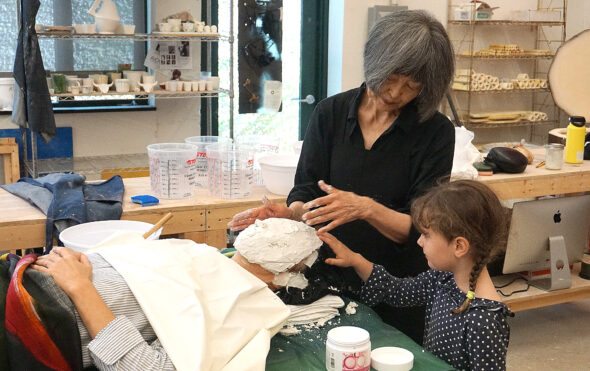
Artist Myong Hee Kim, shown above, is in Yellow Springs with the Peace Mask Project — an effort to make masks of 50 villagers. The project comes to town on the 80th anniversary of the bombing of Hiroshima and Nagasaki, and it aims to emphasize the human costs of violence and war. Above: Villager Chloe Manor gets a plaster cast made of her face as her daughter, Ida, watches. (Photo by Reilly Dixon)
Villagers make masks, not war
- Published: August 18, 2025
This August marks the 80th anniversary of the United States dropping two nuclear bombs on Japan, killing an estimated 140,000 people in Hiroshima and 74,000 in Nagasaki.
The majority of the casualties from this attack were civilians; 38,000 were children. Those who survived — the “Hibakusha,” which translates from Japanese to “explosion-affected person” — suffered from leukemia, cancer, radiation poisoning and discrimination for years afterward. To this day, the effects continue to ripple.
Those affected and killed were ordinary folks — complex and regular people with stories, families and aspirations. They had pets, lovers and favorite foods.
Though often relegated to the depersonalized annals of history, these people had names and faces — and the Kyoto-based, community-led Peace Mask Project aims to remind us of that.
This month, the Peace Mask Project landed in Yellow Springs for a brief residency, and coordinators have been working with community members to make 50 masks of villagers’ faces. Those efforts will culminate with an open and free exhibition of the masks Monday–Saturday, Aug. 18–23, at Antioch College’s Herndon Gallery.
The final product of the Peace Mask Project’s residency in Yellow Springs will be a three-dimensional paper mural of 50 local faces — the complex and regular people of our small town — rendered as papier-mâché reminders of the individual lives war can take, of the unique faces it can strip away.
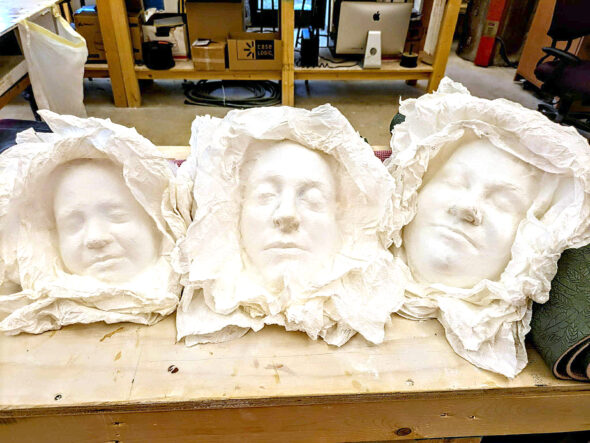
The faces of Ida Westhoff, her mother Chloe Manor and News Editor Lauren “Chuck” Shows
“Every face is important,” Peace Mask Project co-founder Myong Hee Kim told the News earlier this week.
“Your face is important. My face is important. No two are alike,” Kim said. “That’s what these masks can do — show that while these faces are different, we are still all the same.”
Alongside her husband, Robert Kowalczyk, and daughter Kya Kim — an Antioch College alumna — the elder Kim founded the Peace Mask Project over two decades ago with the aim of promoting peace through her art. Kim has made innumerable masks all over the world, from Japan and Korea, to Cambodia and India.
One of the Peace Mask Project’s highest achievements was in 2016–2017, when Kim worked with first- to fourth-generation nuclear bomb survivors in workshops held in Hiroshima, Nagasaki, Kyoto and Korea. From that project, Kim and her collaborators made 100 Hibakusha masks.
“I was so impressed by their strength,” Kim said of the Hibakusha who volunteered their time and faces for mask-making. “Some of these people were in their 80s and 90s. They had scars, but still, they were warm and brave and cheerful. If you look, you see peace on their faces, not pain.”
Earlier this month, those 100 Hibakusha masks found a permanent home in the Peace Resource Center at Wilmington College, just 30 miles south of Yellow Springs.
“I think that maybe the masks were waiting for the right place,” Kim said. “I’ve been with the Hibakusha for a long time, and now, finally, there’s a home for them.”
She added that since completing those masks, she knew they belonged not in Japan, but on American soil — the place where the nuclear bombs were built.
Now in Yellow Springs with her son-in-law, Yellow Springs-grown artist Pierre Nagley, Kim has spent the last week making the 50 masks of willing village volunteers.
In speaking to the News from the Antioch sculpture studio — where Nagley and Kim have headquartered their mask-making operation — Nagley said the Peace Mask Project has a natural kinship to his hometown.
“Yellow Springs is a place that generally embraces the whole idea of peaceful co-existence,” he said. “Though we might disagree on some things, we still have to get along and live here together. Yellow Springs people seem to think about peace in the world and inside themselves, despite all the struggle. But that struggle is a method to get to peace — it doesn’t have to be from conflict.”
Nagley also said that villagers can learn something in making their own Peace Masks, or upon seeing the upcoming exhibition.
“No matter what race or gender you are, the finished masks show our collective humanity,” he said. “That’s really the message here — that we’re in this together, and if you look at us from a distance, we’re all human beings who want to be happy and healthy in our homes.”
Though he’s back in town for a few weeks for the Peace Mask Project, Nagley’s home is in Kyoto with his wife, Kya Kim. When he’s not illustrating or making art of innumerable media, Nagley has spent his recent time building a French restaurant in Kyoto.
The elder Kim lives outside of the city in a small rural village of Imadera in the Fukui Prefecture. From her small studio, she works on masks, paints with black ink on handmade paper and makes and stylizes textiles.
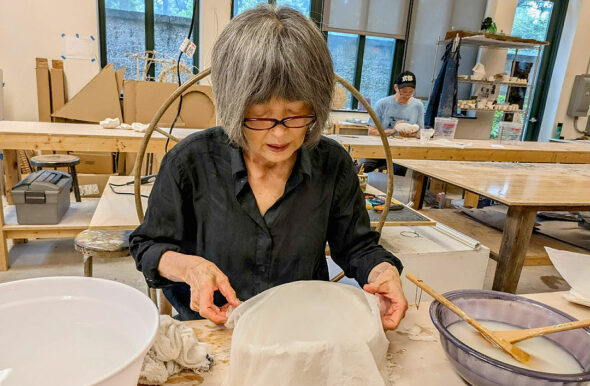
Myong Hee Kim is pictured working with washi — traditional Japanese paper handmade from the inner bark of the paper mulberry, or kozo bush — as she papier-mâchés the plaster mold of a Peace Mask. In the background is Kim’s son-in-law and Yellow Springs native, Pierre Nagley, who is shown repairing the mold of another mask. (Photo by Lauren “Chuck” Shows)
A ‘meditative’ process
From start to finish, the production of a Peace Mask takes a few hours.
The first step: making a plaster mold of a volunteer’s face. The first volunteer on Monday was villager Chloe Manor, who laid on a workbench at the center of the Antioch sculpture studio. Kim draped a hand-woven piece of fabric over Manor’s legs for comfort.
The artist massaged a Korean cream into Manor’s face and then applied little sheets of paper over the eyes, on the eyebrows and around the hairline. With soft, but deliberate movements, Kim applied strokes of plaster over Manor’s face, covering every contour and wrinkle, with small tubes left in the nostrils for breathing. As the plaster set, it began to warm, creating a sensation not dissimilar from the warmth of a direct sunbeam, Nagley said. After a minute or two, Kim gently chipped the plaster off, and what was left was a concave mold — a hardened impression of Manor’s face.
“It was a beautiful experience,” Manor said after washing excess plaster from her face. “At first, when the plaster went over my mouth, I felt a little scared … but I had to be trusting and take deep breaths through my nose.” She added that Nagley’s comparison of the warming plaster to the warmth of the sun gave her some comfort.
Following Kim’s earlier prompt, Manor also meditated on messages implicit in the Peace Mask Project while she lay on the workbench as Kim’s worked.
“I was really thinking about the ritual of this project — and how when the bombs went off, so many people were robbed of their rituals,” Manor said. “We still have the privilege of doing rituals around big things in our lives. We process so much with rituals, don’t we?”
After Kim finished Manor’s mold, Manor’s 6-year-old daughter, Ida, nervously took to the table. As Kim deftly maneuvered her hands across young Ida’s face, Manor stood by, holding her daughter’s hand. Occasionally, Manor would ask Ida to wiggle her toes if everything was OK.
“It felt really weird,” Ida later said, giggling.
After the plaster casts were dried, and bits of dried plaster were dutifully cleared from the impressions of a nose, an eyelid or the lips, Kim moved onto making the papier-mâché.
This part of the process involves pressing five delicate sheets of traditional Japanese washi — thin, hand-processed paper made from the inner bark of the paper mulberry, or kozo bush — into the plaster mold, and applying them with a wheat paste.
As each layer was applied, Kim used moistened towels — “Old towels are best,” she said — to gently work the washi first into the deep crevice of the nose, where each mask is anchored, and then onto the rest of the face mold. Dabbing tenderly, she worked over any wrinkles or bubbles that appeared as the washi was carefully stretched over the mold, until each layer was smooth, revealing only the textures that might appear naturally on the skin.
Kim worked quietly creating the mask of Manor’s face, and told others present, whom she helped to create their own masks, that they were welcome to follow suit as they, again, meditated on the purpose beneath the work.
“This is a very important time,” she said. “Take your time, and if we don’t talk, that’s OK —- our hands work.”
With a day’s worth of masks created, Kim and Nagley set to drying the masks — partially in the sun, but mostly with the aid of hair-dryers. Once the washi was dry and hardened, they lifted each mask from their molds — which models were invited to keep — and what was left were off-white, convex impressions of each face. With closed eyes and a relaxed mouth, the expressions looked serene and placid — peaceful, even.
Finishing up for the day, Kim picked up a stack of note cards, on which that day’s mask models had written thoughts about peace, and which Kim and Nagley plan to take back to Japan. She read aloud the note card signed by young Ida: “Peace means no wars and I hope we can gain peace.”
The exhibition of the Peace Mask Project will open in the Herndon Gallery at Antioch College, Aug. 18–23. The exhibition will be free and open to the public.
*Lauren “Chuck” Shows contributed to this story.
The Yellow Springs News encourages respectful discussion of this article.
You must login to post a comment.
Don't have a login? Register for a free YSNews.com account.









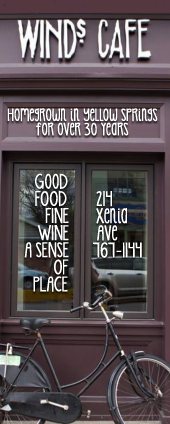

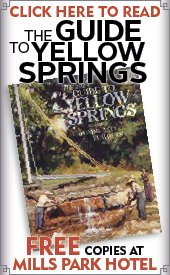



No comments yet for this article.